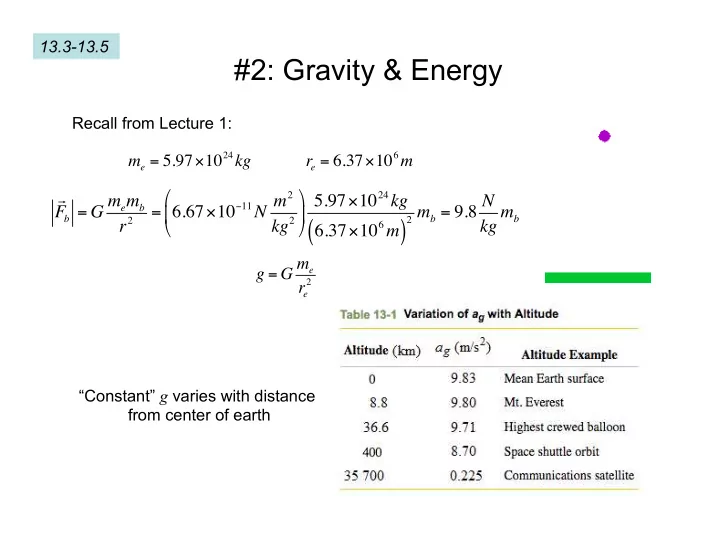

13.3-13.5 #2: Gravity & Energy Recall from Lecture 1: m e = 5.97 × 10 24 kg e = 6.37 × 10 6 m r # & = 6.67 × 10 − 11 N m 2 ( 5.97 × 10 24 kg b = G m e m b 2 m b = 9.8 N F kg m b % r 2 kg 2 ( ) $ ' 6.37 × 10 6 m g = G m e 2 r e “Constant” g varies with distance from center of earth
Reality is more complicated 2. Earth's mass is not distributed uniformly 1. Earth is not a perfect sphere 6357 km 6378 km 3. The Earth rotates F N − ma g = − m ω 2 r F net = F N = ma g − m ω 2 r 2 ! $ 2 π e = 0.03 m ω 2 r = r # & s 2 86,400 s " %
Let’s take a journey through the earth. As you go into earth, does the force that you feel from gravity: A. Increase, B. Decrease, C. Stay the same? At a radius r , only mass enclosed contributes But this is a bad assumption: If the density of earth was uniform: 30% of mass in core (10% volume) r 3 ! $ m enc = ρ 4 3 π r 3 & = m e # 3 r " % e a r = G m enc r 2 = G ρ 4 ! $ 3 π r # & " % a r = r a g r a g = G m e 2 = G ρ 4 ! $ e 3 π r # & e r " % e a r = ?
The figure gives the gravitational acceleration ag for four planets as a function of the radial distance r from the center of the planet, starting at the surface of the planet (at radius R1, R2, R3, or R4). Rank the four planets according to: (a) mass and (b) mass per unit volume, greatest first.
Gravitational Potential Energy Near the surface of the earth NOT Near the surface of the Earth x Let’s send a rocket into space! g ⋅ d r = − G Mm g = − mg ˆ F j = constant dW g = F r 2 dr g ⋅ d ( ) ∞ W g = F d = mg h i − h f g • ∫ ∫ r − 2 W g = F r = − GMm dr r i U g = mgh W g = −Δ U ∞ = − G Mm GMmr − 1 W g = r r i i for rocket to leave Earth E = K + U > 0 W g = −Δ U = U i = − G Mm 2 mv 2 > G Mm 1 r i r i U g = − G Mm 2 GM = (11 km/s) Escape speed v > r r i
The figure shows six paths by which a rocket orbiting a moon might move from point a to point b. Rank the paths according to (a) the corresponding change in the gravitational potential energy of the rocket- moon system and (b) the net work done on the rocket by the gravitational force from the moon, greatest first.
The three spheres with masses m A =80g, m B =10g, and m C =20g, have their centers on a common line, with L=12 cm and d=4.0 cm. You move sphere B along the line until its center-to-center separation from C is 4.0 cm. How much work is done on sphere B: (a) by you and (b) by the net gravitational force on B due to spheres A and C? " % U g = − G Mm U T = − G m 1 m 2 + m 2 m 3 + m 1 m 3 (3 particles) $ ' r r r r # & 12 23 13
The figure gives the potential energy function U(r) of a 25.0 kg projectile, plotted outward from the surface of a planet of radius R s . (a) What speed is required of a projectile launched at the surface if the projectile is to “escape” the planet? (b) If the particle is launched at half that speed, what will be its turning point relative to R s ?
Recommend
More recommend